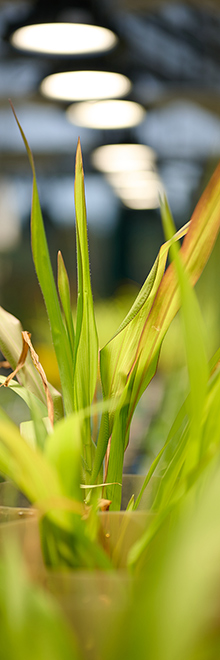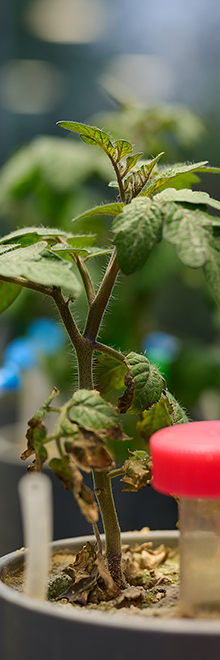Our current research interest
- Relationship between the composition and function of arbuscular mycorrhizal fungal communities
- Plant-soil feedback
- Functioning of arbuscular mycorrhizal symbiosis under drought
- Arbuscular mycorrhizal fungi in arable soils
- Mutual interaction between arbuscular mycorrhizal and ectomycorrhizal fungi and their host plants
- Molecular determination of fungi
- Valorization of plant biomass for nutraceutic and cosmetic products
- Use of microbial inoculations for cultivation of plants in desert environment
Relationship between the composition and function of arbuscular mycorrhizal fungal communities
Roots are colonized by complex communities of mycorrhizal fungi in natural conditions and multiple fungal symbionts often confer more benefits to their host plants than single species. However, we have only limited knowledge on how specific arbuscular mycorrhizal fungal communities establish, and on the relationship between the community composition and mycorrhiza functioning.
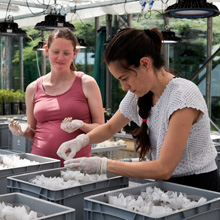
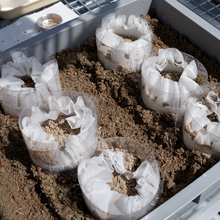
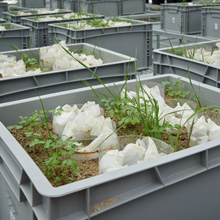
Plant-soil feedback
Plant-soil feedback (PSF) is an important driver of plant species coexistence and we explore it in close collaboration with the Department of Population Ecology. We study spatial variability in PSF and test how the biotic and abiotic soil properties change with distance from the plant rooting center. We want to identify which components of PSF are the most influential in spatial patterns of interaction between plant species. Further, we aim to obtain mechanistic insights into the determinants of intra-specific and inter-specific PSF at the species and genotype level by linking the results of PSF experiments to wide range of plant functional traits, species phylogeny and changes in soil chemistry and soil biota. We also take advantage of a long-term removal experiment established by our collaborators in a species-rich mountain grassland. We intend to address, both in the field and under controlled conditions, how plant dominants influence soil fungal communities and vice versa.
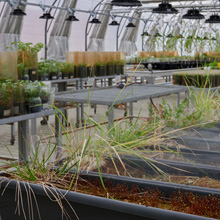
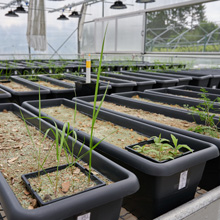
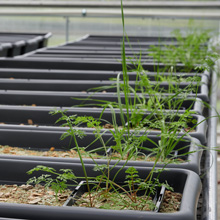
Functioning of arbuscular mycorrhizal symbiosis under drought
We have studied functioning of arbuscular mycorrhizal symbiosis under drought stress since 2017. In a series of greenhouse pot experiments, we cultivate mycorrhizal or non-mycorrhizal model plants in a substrate in which we carefully manipulate water content. Then we quantify how the contrasting water availability, or even a gradient of water availability, changes plant acquisition of nutrients, phosphorus or nitrogen, or even water itself. This involves labeling and subsequent tracing of respective isotopes and is achieved in close collaboration with Institute of Microbiology CAS. Further, in collaboration with IGZ (Germany), we explore how the presence of mycorrhizal structures in the substrate affects its hydraulic conductivity, particularly on a gradient of substrate structure. We are also interested in how are AM fungi resistant to drought, and how drought-related life traits differ among AM fungal species and isolates.
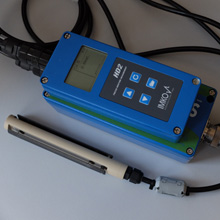
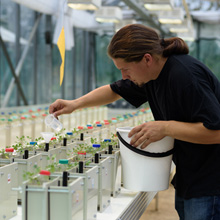
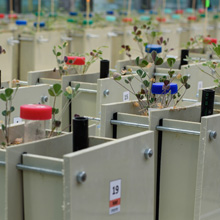
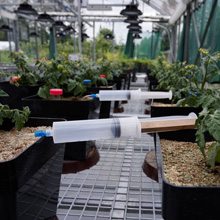
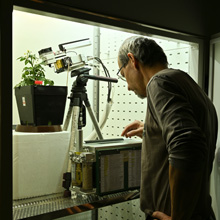
Arbuscular mycorrhizal fungi in arable soils
Intensive agricultural practice decreases the infectivity and diversity of mycorrhizal fungi in soils. We are interested in to which extent are communities of mycorrhizal fungi in arable soils functional and confer benefits to their host plants.
Mutual interaction between arbuscular mycorrhizal and ectomycorrhizal fungi and their host plants
Arbuscular mycorrhizal (AM) and ectomycorrhizal (EcM) fungi form arguably the two most important types of mycorrhizal symbioses in temperate zones. At sites undergoing spontaneous plant succession, AM hosts (herbs and grasses) are replaced by EcM hosts (woody plants). During the transition, AM- and EcM-type plants compete both aboveground (for light) and belowground (through their roots for soil resources). The competition mediated by root-associated fungi might significantly affect the result of this contest. We explore how the two mycorrhizal fungal groups affect each other in the transition process when representatives of both host plant groups coexist side by side. We investigate the effect of interaction between AM and EcM fungal mycelia in the soil on establishment and growth of seedlings of both AM- and EcM-type plants.
Molecular determination of fungi
Sequence based determination is the most widely used method by ecologists to detect fungal taxa nowadays. Implementation of high-throughput DNA-sequencing methods recently enabled to proceed much larger number of samples in much shorter time and obtain high numbers of sequences. In our research, we are developing novel approaches to improve and optimize fungal detection mostly in root and soil samples. Our research is particularly focused on primer and barcoding region choices, assurance of sequence quality and following reliable bioinformatics steps, and the use of resulting DNA sequences in community ecology, phylogenetic analyses and biogeography of fungi. We target mostly arbuscular mycorrhiza fungi from the phylum Glomeromycota.
Valorization of plant biomass for nutraceutic and cosmetic products
Project National Centre of Competence Biocirtech „Valorization of plant biomass using biorefinery technologies“ is focused on non-traditional plant biomas resources and their processing. The project uses unique collections of Botanical Garden at the Institute of Botany, for example large genetic resources of genus Iris. The research aims to develop efficient cultivation methodologies in the greenhouse and field followed by processing and fractioning the biomass, separation of bioactive compounds and methods for their isolation and purification.
Major activities are focused on belowground organs like rhizoms and roots. Innovative separation methods based on non-solid base such as centrifugation separation chromatography are used for the target compounds purification.
These compounds are further investigated for their biological activities targeted on their use in cosmetics and nutraceutical products. Advanced hydroponic systems are tested to optimalize cultivation outputs.
Additional project is financed by the Ministry of Industry and Trade and it is targeted on selection of optimal chemotypes of cannabis with low content of THC and on the effects of microbial amendments (soil yeasts, mycorrhizal fungi, endophytic fungi, endophytic bacteria and microalgae) into cultivation substrate to enhance production of secondary metabolites. Major aim of the project is to reveal interaction of microbiome with production of target secondary metabolites produced by cultivated plants.
Use of microbial inoculations for cultivation of plants in desert environment
The project is a part of presentation of the Czech Republic at EXPO2020 in Dubai. Using the system SAWER developed by Czech Technological University the irrigation water is produced from desert air. By application of microbial inoculants the fertility of desert sand is enhanced. The aim is to develop sustainable ornamental and crop production garden in desert in front of the Czech pavilion. For greening of marginal infertile soils combination of several technologies is being used: subsurface irrigation system, enrichment of sand by vermicompost tea, by biomass of microalgae produced in photobioreactor and by inoculation of plant beneficial microorganisms.
